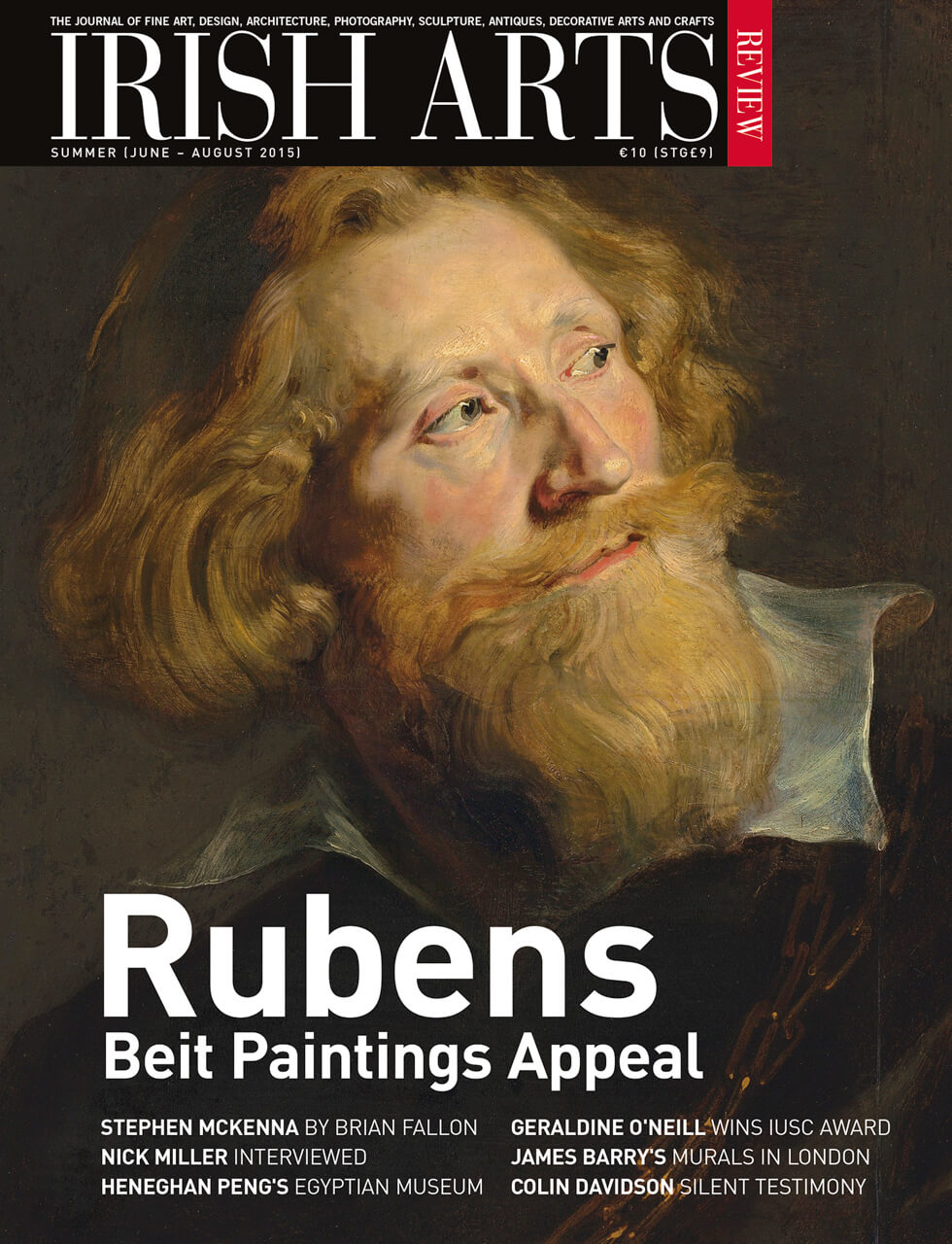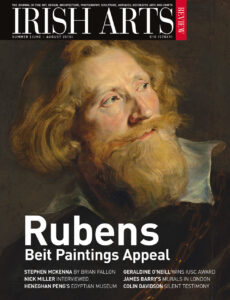

James Watson could trace his family’s artistic lineage to York Minster and following his move to Cork he launched a new tradition to last a hundred years, writes Vera Ryan.
In the mid 1880s when James Watson first came to Youghal, County Cork, a new era in stained glass in Ireland was underway. The Yorkshire man (born c. 1860) was employed by Cox, Sons, Buckley and Co., ecclesiastical decorators commissioned to design an altar for St Mary’s Catholic church. The designer Michael Buckley, a partner in the firm, had strong ties with Youghal and had trained in Bruges. The altar was made by Dublin-based ecclesiastical decorators Pearse and Sharp. Englishmen James Pearse, father of PH and Willie, Joshua Clarke, father of Harry, and James Watson all came to Ireland at a time when there was a great demand for ecclesiastical decoration and an acute awareness of the need for enterprises providing employment.1 In 1889, the Manchester Guardian reported that ‘ £20,000 is annually sent out of Ireland for ecclesiastical ornaments’ and further commented that ‘a well known firm of ecclesiastical decorators ‚Ķ Messrs Cox & Buckley of Southampton Street, London have lately opened a branch establishment in Youghal. I cannot describe the pleasure it gave me to see Irish lads learning to paint on glass’.2 Adding drawing, glazing, firing, leading, installing and other necessary skills, ‘Irish lads’ in Youghal continued to paint on glass, as James Watson bought out the Youghal branch in the mid 1890s and his descendents made stained glass windows there until 2012.
The name and places of business – Cox, Sons, Buckley and Co., Youghal and London – on the bottom right of the St Elizabeth of Hungary window in All Saints Church in Ballinakill, Co Laois, clearly identify the firm as its maker. In various incarnations, the firm made other windows here including The Resurrection window. At public auction in 2014, the Crawford Art Gallery bought hundreds of cartoons, watercolours and documents from the Watson studio. Among these, a miniature design in monochrome stamped Cox, Sons, Buckley and Co., on the back, a small watercolour and fine large cartoons (Fig 4) with the Watson and Co., stamp relate closely to the Ballinakill Resurrection window. When buying out the firm, James Watson acquired its stock; establishing the influence of the parent firm is one of the challenges of telling the story of the Watson studio.
The importance of their parish church at home was often great for those who left Ireland. Many commissions for Watson windows came from priests who had gone on the missions and set up churches abroad. In Clogheen, Co Tipperary the JJ Mc Carthy church (St Mary’s, 1864) was built with a fervour reminiscent of that harnessed to construct the 13th-century Gothic cathedrals.3 Locals volunteered to bring stone from nearby quarries. A curate was sent out to Australia where some emigrants from Clogheen had made money in the goldrush and a hefty sum was raised. Some twenty-five years after the opening of the church Fr Phelan commissioned James Watson to execute windows of the Baptism of Christ and Ecce Homo (Fig 5) costing £60.4 The Slattery family donated these windows, which show keen attention to figurative representation. Two richly-coloured tall lights with angels and musical instruments were commissioned for the organ gallery. Fr Phelan placed another order with Watson’s in 1901, but the three windows on the south gable wall are unsurpassed. The Crawford acquired the watercolour and one cartoon (Figs 7&8) for the Angel window.
Munster was the main sphere of Watson business, which continued to include ecclesiastical decoration for many years. The order books show that nuns were trusting clients, even if their spending was comparatively sparse. Reflecting the religious geography of the region, and the increasing institutionalization of Catholicism, the majority of Watson windows were made for Catholic churches.5 Major themes include the Sacred Heart, the Immaculate Conception and the Apparation at Lourdes, and both local Irish and universal Catholic saints. In the Watson windows in St Colman’s Collegiate Chapel in Fermoy, Co Cork, which was endowed by Canon Sheehan, the use of Irish script for Latin text suggests a symbiosis between faith and motherland (Fig 2).
Watson windows were shown at many of the international exhibitions of the time, including the St Louis World Fair in 1904. An T√∫r Gloine, set up by Sarah Purser the previous year, also participated at St Louis. Watson windows remained more traditional than those coming from An T√∫r Gloine or the Clarke studio. The Watson method of training, with apprentices doing the canopy work and perhaps the robes, while the master painter did the faces, reflected continuity of age-old practices. Indeed Watson’s had stained-glass workers in their family going back to York Minster. By contrast, education in art schools, as well as in the workshop deepened commitment to individuality of artistic expression in the ethos of An T√∫r Gloine and the later phases of the Clarke studio. Both studios quickly came to prominence to form the golden age of Irish stained glass.
The presence in the Watson Archive of at least three large cartoons of Christ the Light of the World attests to its importance in their workshop. They made perhaps a dozen large Light of the World windows. These are based directly on Holman Hunt’s painting of the same name, itself based on Scripture, and position the Watson glass in the Pre-Raphaelite tradition. A Light of the World window was commissioned for St Mary’s, Thurles, by Mrs Knox of nearby Ballybrittas Castle in 1912. It commemorates her husband Fitzroy Knox and is very finely made. As light from outside washes through the ruby glass and bleeds into the church, this and other Light of the World windows can be solemnly impressive, notwithstanding the use of the Holman Hunt image. A few short years later the Knox’s son was killed in the Great War and is commemorated by a wall plaque in the church.
Perhaps one of the most poignant juxtapositionings of father and son memorials during the years of the Great War is in the Methodist Church in Youghal. The Merrick father and son are commemorated in two small windows here. In one, the figure of the Sower looks towards the David figure, who steadies himself for battle (Figs 1&2). David’s coppery pink tunic harmonizes with the Sower’s rich orange one. Good craftsmanship, high quality glass, (imported, probably antique mouth blown), the fine face painting of the Sower and the sequential positioning at chest height combine to convey the sadness of the narrative. Honouring a group of young Corkmen who also died in the Great War, the David window in Christchurch, now Triskel Christchurch, Cork is based on the same cartoon. Its style and the presentation of the preliminary drawings are untypical of Watson’s.
GM Parlby cartooned the Watson windows commemorating Mrs Webster, the rector’s wife at St Michael’s, Blackrock, Cork, whom legend has it died from an accident while hanging curtains just before Christmas 1917. The four female figures are notably beautiful, both in the cartoons and windows. The details of Dorcas’ sewing basket and scissors are rendered in sumptuous glory. Dorcas, the generous widow whom St Peter raised from the dead, is not often represented in stained glass. Based on a different cartoon, she does appear in that jewel of gentry churches with Watson windows, Clonbeg in the Glen of Aherlow.6
In the last decade of his ownership of James Watson and Co., James produced a suite of windows for the Church of the Holy Rosary in Murroe, Co Limerick. Marian Neville suggests that winning the highest award for glass at the Munster and Connaught Exhibition in Limerick in 1906 may have led to the commission.7 The windows imaging the Joyful, Sorrowful and Glorious Mysteries of the Rosary link with the church dedication and demonstrate the great skill Watson’s had in making intricate Celtic designs in stained glass. Cultural nationalism finds its most distinct expression here in the window of St Patrick Baptising St Aonghus at Cashel.
Clement Watson came back from serving in the Great War and bought the business from his father in 1920. Watson and Son faced the challenges of doing business at a time when a diversity of political and religious allegiances was not always easy to negotiate. The early 1920s saw very successful windows installed in both Catholic and Protestant churches. In east Cork, St Ita’s Church in Gortroe has windows of great intensity which feature Celtic ornamentation, while St Anne’s in Castlemartyr has a richly coloured and quite magnificent Ascension.
During the Second World War, Cornelius Crowley donated a Blessed Oliver Plunkett window to Millstreet, Co Cork. Then in the early 1980s, long after Clement had died and five of his seven sons were working in the business, came a commission to do martyr windows in St Edmund’s in Salisbury. A variant of an older Oliver Plunkett cartoon was used for the Plunkett window. For the remaining martyr windows, Watsons created new drawings quite different in style to the St Oliver Plunkett one. Despite the stylistic differences, the three figurative windows were well received. The tradition of windows of different styles in the same church is a time-honoured one.
Changes in Catholic churches after the Second Vatican Council brought business, especially in collaboration with architects. The use of miniature designs to win commissions, and of cartoons which had been at the heart of the work done by the glazier and painter did diminish. Other production factors had already changed. The Church of the Holy Family (1994) in Youghal is the closing chapter in the story of the Watson family firm.8 Designed by Boyd Barrett Murphy O’Connor, it re-houses the Mayer and Co., windows which had been in the old Presentation Convent and contains a richly affective abstract Holy Spirit/sunburst window by Watson’s. David Lawrence, writing in a different context, recommended the re-appraisal of this little-appreciated studio’.9 This re-appraisal began with the Crawford Art Gallery’s ambitious acquisition of so much Watson material.
Acknowledgements: Thanks to Elsie Beston, Fr Pat Butler, Kathleen Crowley, Stephen Daunt, Nessa Durcan, Mr Good, Revd Canon Patrick Harvey, Eddie Hyland, David Kelly, Tim Kingston, Noreen McSweeney, Revd Bill Mullally, Mrs Mullally, Margaret O’Riordan, Seán Radley, Willie Smyth, John Tuohy, Lottie West, George Willoughby, the Watson family, and all the staff at Crawford Art Gallery.
Vera Ryan curated the recent ‘Angels in Danger The Watson Archive’ at the Crawford Art Gallery, Cork.
1 Thomas Earley came to Dublin to set up a branch of Hardman and Co. in 1853. His own firm Earley and Powell later became very successful.
2 Published in Cork Daily Herald, 23 August 1889.
3 Ed O’Riordan, Dominus Vobiscum A History of St Mary’s Church Clogheen 2014
4 The stained-glass windows on the altar wall are by Earley and Powell.
5 David Lawrence has shown that there are Watson windows in more than eighty Church of Ireland churches. See www.gloine.ie
6 Mandy Parslow ‘Clonbeg Church and its Association through Stained Glass with James Watson and Company’ unpublished MA thesis (History of Art and Architecture) UL 2009.
7 Marian Neville ‘Stained Glass Windows’ Murroe Parish Newsletter Oct. 2006.
8 Jo Kerrigan in ‘Stained Glass through the Ages – the Watson family of Youghal Co Cork’ Ireland of the Welcomes March/April 2002 draws attention to the work of Peter Watson, grandson of Clement, who ran his own business in stained glass. He was killed in a road accident in 2004.
9 David Lawrence ‘Art Historical Assessment; the Diocese of Casheland Ossory’ unpublished report. p.12



